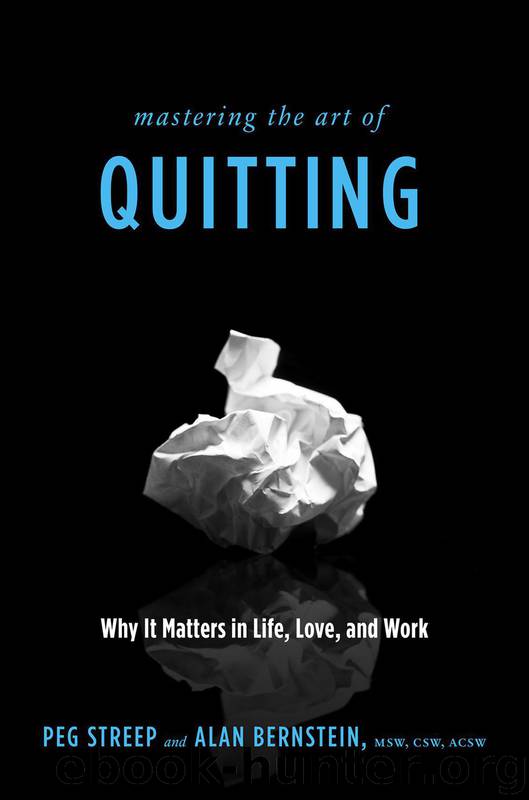Mastering the Art of Quitting: Why It Matters in Life, Love, and Work by Peg Streep & Alan Bernstein

Author:Peg Streep & Alan Bernstein [Streep, Peg]
Language: eng
Format: mobi
Publisher: Da Capo Press
Published: 2013-12-23T14:00:00+00:00
CHAPTER SEVEN
Mapping Your Goals
For years, many books and talks famously included a reference to a supposedly renowned and definitive study—variously attributed to the Harvard MBA class of 1954 or the Yale class of 1979—that explained why 3 percent of the class had made ten times more money than the other 97 percent within ten years after graduation. The answer was deliciously simple and very cool: The 3 percent had written their goals down. It’s not hard to see why this supposed study made a fabulous sound bite—easy-to-remember numbers, marquee schools, and an easy way to guarantee success.
Not an Urban Legend, After All
Alas, no such study was ever conducted. But like the alligators in the New York City sewers, this urban legend deserves to be true. As it happens, a study done in 2011 at McGill and Toronto Universities shows that writing down goals is beneficial and that elaborating and reflecting on personal goals actually improves the performance of struggling students. Putting your goals in writing can enhance your ability to evaluate whether your efforts to reach a goal are working and whether attaining it is feasible; it helps clarify whether you should continue to pursue a goal or disengage from it. Mapping also allows you to see your goals in relation to each other, which is invaluable.
We mean goal mapping in a rather literal sense, with pen and paper or a computer screen at hand. (We suppose that if you’re fabulously good at visualizing, you might even be able to do it in your head.) For most of us, though, writing about something clarifies our thought processes in important ways and forces us to be more articulate and concrete about our wants and aspirations. You can read through the pages of this chapter first without mapping your goals on paper or screen, if you like, and then double back, or you can map them, step-by-step, as you read.
Listing Your Goals
Use the following categories to organize your goals. Make two columns, one for short-term goals and the other for long-term ones. You can, if you wish, personalize the categories further; they are meant only as a starting point. Feel free to include any goals you think are pertinent. How you define short term and long term is up to you; a short-term goal can be defined in months or years as you wish.
Life Goals (Personal Strivings)
Your life goals include personal aspirations that pertain to the growth of the self (becoming a better leader, being less impulsive, feeling better about your choices, making peace with your limitations, for example). They can be broad or abstract (becoming a better listener, being more mindful, cultivating gratitude, being more responsive to others) or concrete (reading more books, wasting less time online, spending less money, working to resolve disputes, mastering a new language). They should include both approach goals—such as having children, being financially stable, owning a home, traveling the world, or doing anything else important to you—and goals focused on avoidance.
Career or Work Goals
The goals
Download
This site does not store any files on its server. We only index and link to content provided by other sites. Please contact the content providers to delete copyright contents if any and email us, we'll remove relevant links or contents immediately.
Rewire Your Anxious Brain by Catherine M. Pittman(18285)
Talking to Strangers by Malcolm Gladwell(12864)
The Art of Thinking Clearly by Rolf Dobelli(9908)
Mindhunter: Inside the FBI's Elite Serial Crime Unit by John E. Douglas & Mark Olshaker(8697)
Becoming Supernatural by Dr. Joe Dispenza(7831)
Change Your Questions, Change Your Life by Marilee Adams(7371)
The Road Less Traveled by M. Scott Peck(7274)
Nudge - Improving Decisions about Health, Wealth, and Happiness by Thaler Sunstein(7238)
The Lost Art of Listening by Michael P. Nichols(7157)
Mastermind: How to Think Like Sherlock Holmes by Maria Konnikova(6936)
Enlightenment Now: The Case for Reason, Science, Humanism, and Progress by Steven Pinker(6869)
Win Bigly by Scott Adams(6823)
The Way of Zen by Alan W. Watts(6288)
Daring Greatly by Brene Brown(6221)
Big Magic: Creative Living Beyond Fear by Elizabeth Gilbert(5348)
Grit by Angela Duckworth(5295)
Men In Love by Nancy Friday(4963)
Ego Is the Enemy by Ryan Holiday(4950)
Altered Sensations by David Pantalony(4863)
